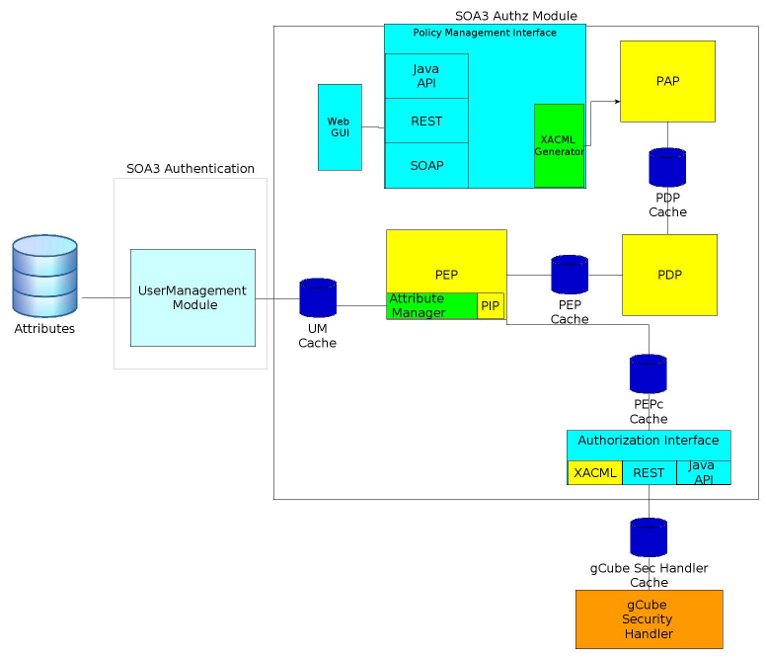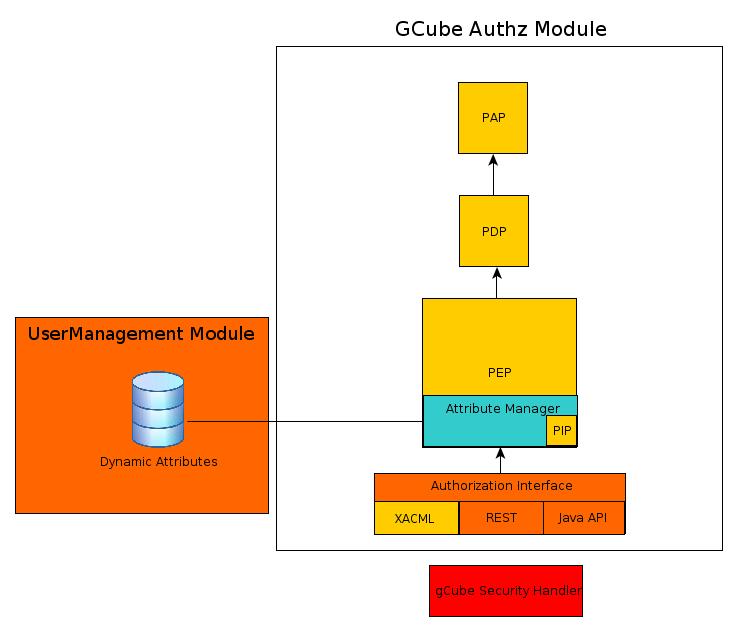SOA3 Authorization Module
Overview
Authorization is the function of specifying access rights to resources and enforcing the taken decisions. There are diverse Authorization models: SOA3 Authorization Module bases its decisions on stored policies by which it is able to determine if a subject can perform a certain action on a certain resource. Since the subject is defined by a set of attributes referred to the caller, the call and the environment, the adopted model is defined as Attribute Based Access Control (ABAC) [1]. ABAC is a very flexible model, which can be view as a generalization of Role Based Access Control[2], where the only allowed attributes are roles.
In particular the module:
- receives Authorization Requests containing caller and call related attributes from gCube Security Handler
- evaluates if the caller is authorized to perform a certain action basing the decision on received attributes, environment attributes and stored policies
- returns Authorization Responses to gCube Security Handler
GCube Security Handler could contact SOA3 Authorization Module in different ways: in particular a strict integration could be obtained by using Java Library API or it is possible to have looser dependencies by web service interfaces, SOAP and RESTful. In order to obtain a zero-dependencies model the RESTful interface is used sending the following parameters:
- call and caller attributes, at least user role
- requested service's id, representing the resource in authorization terms
- requested operation's label, representing the action
Key features
- Attribute Based Access Control Model
- a very general and extensible model which base the decisions on a set of attributes from the caller, the call and the environment
- Policy based decisions
- the decisions are based on a set of pre-defined policies stored
- Standard based architecture
- the module is based on the standard eXtensible Access Control Markup Language (XACML) [3]
- Graphical policies management interface
- a portlet is available to define and manage policies
- Extensible set of attributes
- Possibility to configure the attributes set to be used for policies evaluation
- High availability
- redundancy and load balancing for improving performance
Design
Philosophy
The module provides Authorization as a Service, in particular gCube Security Handler sends a REST request to the exposed web service and receives an authorization response. The module is totally decoupled from gCore: the only connector is gCube Security Handler, which generates REST requests and interprets SOA3 responses. Modularity and compliance to XACML standard has a paramount importance, in fact from the architecture is very easy to distinguish the four main modules of a canonical XACML Authorization architecture:
- Policy Administration Point (PAP)
- Policy Decision Point (PDP)
- Policy Enforcement Point (PEP)
- Policy Information Point (PIP)
The use of XACML standard and the presence of clearly identified modules makes the architecture extensible and manageable.
XACML standard and the presented architecture is totally agnostic on the semantic of data included in the requests: in other words SOA3 doesn't make any hypothesis on the meaning of the attributes, resource ids or action labels. This provides a very strong flexibility on policies composition and attributes or id assignment.
Architecture
The architecture is based on the features provided by Argus Authorization Framework [4], which provides the first functionalities of PAP, PDP, PEP and PIP. SOA3 Authorization Module added value is the possibility to consider more than an attribute to take decisions and, more in general, to manage complex policies.
- Policy Management Interface receives policies management requests, translates them into XACML form and forwards the generated message to PAP's SOAP web interface. The component leverages the full power of XACML syntax by XACML generator in order to perform CRUD operations on policies. In particular it allows to create, read, update, and delete both policies and policy sets. Policy Sets management is useful in very dynamic environments, such as cloud environment, providing the quick insertion and deletion of sets of policies related on dynamic resources.
- Web GUI is a Portlet integrated into IMarine Portal providing a graphical presentation of policy management operations. It is decoupled from Policy Management Interface and communicates with it by using the web service REST interface. Web GUI is strictly integrated with IMarine infrastructure, in particular it leverages IS services in order to load the services list (representing the resources) and available roles (representing the most important attributes).
- Policy Administration Point is a storage for the policies. It exposes two SOAP web services, one for managing policies and one for providing policies for decisions. PAP receives the policies in XACML format from Policy Management Interface and stores them in the same format.
- Policy Decision Point takes authorization decisions basing on policies and attributes. It has two web service interfaces:
- Policy Decision Query interface receives XACML Policy Decision Query messages containing attributes, action id and resource id and returns an Authorization Response stating if the authorization has been grant
- Policy provisioning interface asks PAP for policies and receives them
- Policy Enforcement Point receives Policy Authorization requests containing call and caller attributes, resource id and action label, adds environment attributes, creates Policy Decision Query messages and forwards them to PDP Policy Decision Query interface. PEP contains two sub-modules:
- Attribute Manager, which retrieves any extra attribute required for the decision. In particular some extra attributes could be stored in the user LDAP and not be carried by the request: Attribute Manager leverage User Management module in order to load those attributes from user storage
- Policy Information Point, part of Attribute Manager, specialized in loading and managing environment attributes, such as time or date
- Authorization interface is the connector between PEP XACML Authorization Request interface and the world external to SOA3. This interface can work in three different ways:
- transparent way, forwarding XACML requests to PEP
- as a web service converter, receiving REST messages containing authorization request information and generating the XACML message
- as a java connector integrated into the external application
In gCube context, in order to remove all the possible dependencies, the REST interface is used for interconnecting gCube Security Handler to SOA3 Authorization Module
Deployment
GCube Authorization module should be deployed per Virtual Organization: in particular there should exist a module for each VO and the module should protect all the resources belonging to that VO.
Large deployment
The maximum scalability is obtained using load balancers between PDP and PAP, PEP and PDP and also Authorization interfaces and PEP. The diagram is similar to the architecture diagram above.
Small deployment
A minimal solution is the following:
Use Cases
Since the subsystem is currently under test there are no "success stories" available

